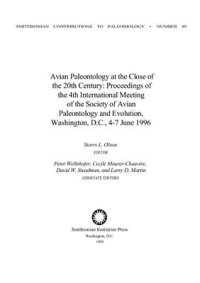
Ebook: Implications of the Cranial Morphology of Paleognaths for Avian Evolution
Author: Dzerzhinsky Felix Y.
- Genre: Biology // Zoology
- Tags: Биологические дисциплины, Зоология
- Language: English
- pdf
Smithsonian Contributions To Paleobiology. Number
89. Smithsonian Institution Press. Washington, D.C. 1999. 9 pages
In the early evolution of birds, bill formation produced a problem for muscular control of the thin, elongated upper jaw. In particular, it required a relatively high retracting force. Three sources
of this force evolved. (1) A powerful M. retractor palatini (especially in Tinamiformes and Apteryx), originating primarily on the vomer and pterygoid, developed to provide direct muscular con-
nection between the dermal palate and the cranial base. It apparently evolved due to a joining of the medial portions of the pterygoid and mandibular depressor muscles, which were aligned
by development of the proc. mandibulae medialis (a character unique to birds). (2) The ancestral pseudotemporalis muscle developed into two portions, a large postorbital portion and an almost
horizontally oriented intramandibular portion. Each portion seves to increase the retraction ability of the muscle as a whole. (3) The external mandibular adductor muscle developed, which, in neo-
gnaths, is larger than either muscle previously mentioned. Its evolutionary development was temporarily retarded by reduction of one of its places of origin—the upper temporal arch.
89. Smithsonian Institution Press. Washington, D.C. 1999. 9 pages
In the early evolution of birds, bill formation produced a problem for muscular control of the thin, elongated upper jaw. In particular, it required a relatively high retracting force. Three sources
of this force evolved. (1) A powerful M. retractor palatini (especially in Tinamiformes and Apteryx), originating primarily on the vomer and pterygoid, developed to provide direct muscular con-
nection between the dermal palate and the cranial base. It apparently evolved due to a joining of the medial portions of the pterygoid and mandibular depressor muscles, which were aligned
by development of the proc. mandibulae medialis (a character unique to birds). (2) The ancestral pseudotemporalis muscle developed into two portions, a large postorbital portion and an almost
horizontally oriented intramandibular portion. Each portion seves to increase the retraction ability of the muscle as a whole. (3) The external mandibular adductor muscle developed, which, in neo-
gnaths, is larger than either muscle previously mentioned. Its evolutionary development was temporarily retarded by reduction of one of its places of origin—the upper temporal arch.
Download the book Implications of the Cranial Morphology of Paleognaths for Avian Evolution for free or read online
Continue reading on any device:

Last viewed books
Related books
{related-news}
Comments (0)